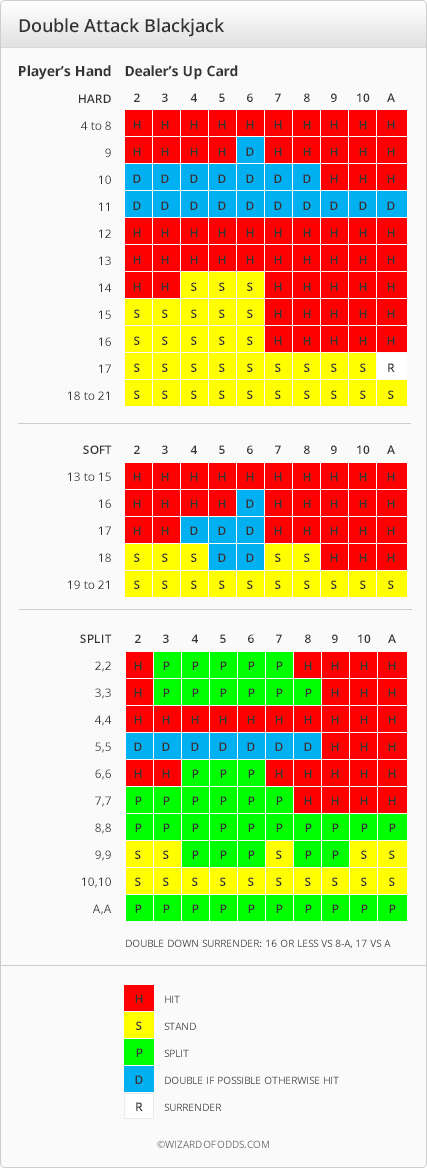On this page
Double Attack Blackjack
Introduction
Double Attack Blackjack is a blackjack variant with lots of rule twists. The most interesting is that the player may double his bet after the dealer's up card is dealt, before any player cards are. The game is popular in Atlantic City, where it can be found in about half the casinos. As of May, 2010, it was at the El Cortez in Las Vegas.
Rules
BustIt Side Bet
| Event | Pays |
|---|---|
| Dealer has suited 888 | 200 to 1 |
| Dealer has colored 888 | 50 to 1 |
| Dealer busts with 6 | 15 to 1 |
| Dealer busts with 7 | 10 to 1 |
| Dealer busts with 8 | 8 to 1 |
| Dealer busts with 9 | 6 to 1 |
| Dealer busts with face card | 3 to 1 |
- Eight 48-card "Spanish" decks are used. A Spanish deck consists of the conventional 52 cards, less the four tens.
- Dealer stands on soft 17.
- Dealer shall peek for blackjack.
- Player may double after a split.
- Aces may not be resplit, all other pairs may be resplit to 3 or 4 hands, depending on the specific casino. The analysis that follows is based on resplitting to four hands.
- Winning player blackjack pays even money.
- Player may double or surrender at any time, including after splitting. Any one hand may be doubled only once (no redoubling). Surrender after splitting is done on a hand-by-hand basis.
- Split aces receive one card only.
- Insurance pays 5 to 2.
- The first card dealt is the dealer's up card. Immediately after this card is dealt, the player has the option to "Double Attack" by raising his bet. The raise may be up to the original wager. If the player later splits, he must match his Double Attack Bet, if he made one. If the player doubles, he may do so up to the sum of the original wager and Double Attack bet. If the player surrenders, he will be refunded half his original and Double Attack bet.
- An optional "BustIt" side bet is also available. The "BustIt" bet pays if the dealer busts with exactly three cards. Otherwise, the "BustIt" bet shall lose. Most wins will pay based only on the dealer's third "bust" card, as follows. There is a premium win if the dealer's three cards are all eights.
Strategy
Following is the basic strategy for Double Attack Blackjack. "Double Down Surrender" refers to when to surrender after doubling down.

The next table shows the expected value against each dealer up card. Correct strategy is to raise with an expected value greater than zero. The table shows the player should raise if the dealer's up card is a 2 to 8.
Double Attack Blackjack
| Dealer Card | Probability | Expected Value | Bet | Return |
|---|---|---|---|---|
| Ace | 0.083318 | -0.322833 | 1 | -0.026898 |
| 2 | 0.083472 | 0.002528 | 2 | 0.000422 |
| 3 | 0.083458 | 0.027849 | 2 | 0.004648 |
| 4 | 0.083399 | 0.05884 | 2 | 0.009814 |
| 5 | 0.083378 | 0.093619 | 2 | 0.015611 |
| 6 | 0.083352 | 0.132934 | 2 | 0.022161 |
| 7 | 0.083320 | 0.093325 | 2 | 0.015552 |
| 8 | 0.083310 | 0.01911 | 2 | 0.003184 |
| 9 | 0.083273 | -0.066712 | 1 | -0.005555 |
| 10 | 0.249721 | -0.180725 | 1 | -0.045131 |
| Total | 1 | -0.006191 |
House Edge
The table above shows the house edge is 0.62%.
The player will raise 58.3% of the time. Additional money will also be bet doubling and splitting. The ratio of expected player loss to total money bet, the Element of Risk, is 0.35%.
Insurance
The following return table is for insurance with a house edge of 12.27%.
Insurance
| Event | Pays | Combinations | Probability | Return |
|---|---|---|---|---|
| Win | 2.5 | 96 | 0.250653 | 0.626632 |
| Loss | -1 | 287 | 0.749347 | -0.749347 |
| Total | 383 | 1 | -0.122715 |
BustIt Side Bet
The following table shows the probability and return for all possible outcomes of the BustIt side bet with a house edge of 8.01%.
BustIt Side Bet
| Event | Pays | Combinations | Probability | Return |
|---|---|---|---|---|
| Suited 888 | 200 | 1344 | 0.000024 | 0.004784 |
| Colored 888 | 50 | 5376 | 0.000096 | 0.004784 |
| Dealer busts with 6 | 15 | 287744 | 0.005122 | 0.076825 |
| Dealer busts with 7 | 10 | 617472 | 0.010991 | 0.109907 |
| Dealer busts with 8 | 8 | 968192 | 0.017233 | 0.137866 |
| Dealer busts with 9 | 6 | 1366016 | 0.024314 | 0.145886 |
| Dealer busts with 10 | 3 | 5366784 | 0.095526 | 0.286577 |
| Loser | -1 | 47568576 | 0.846695 | -0.846695 |
| Total | 56181504 | 1 | -0.080064 |
Methodology
A combinatorial program was used to determine total-dependent basic strategy. Then, this strategy was run through a random simulation in an eight-deck game, with cut card. This will result in a slightly higher house edge than a composition-dependent analysis, based on the first hand in the shoe, which is how blackjack is often analyzed, but in my opinion does not represent realistic playing conditions.


